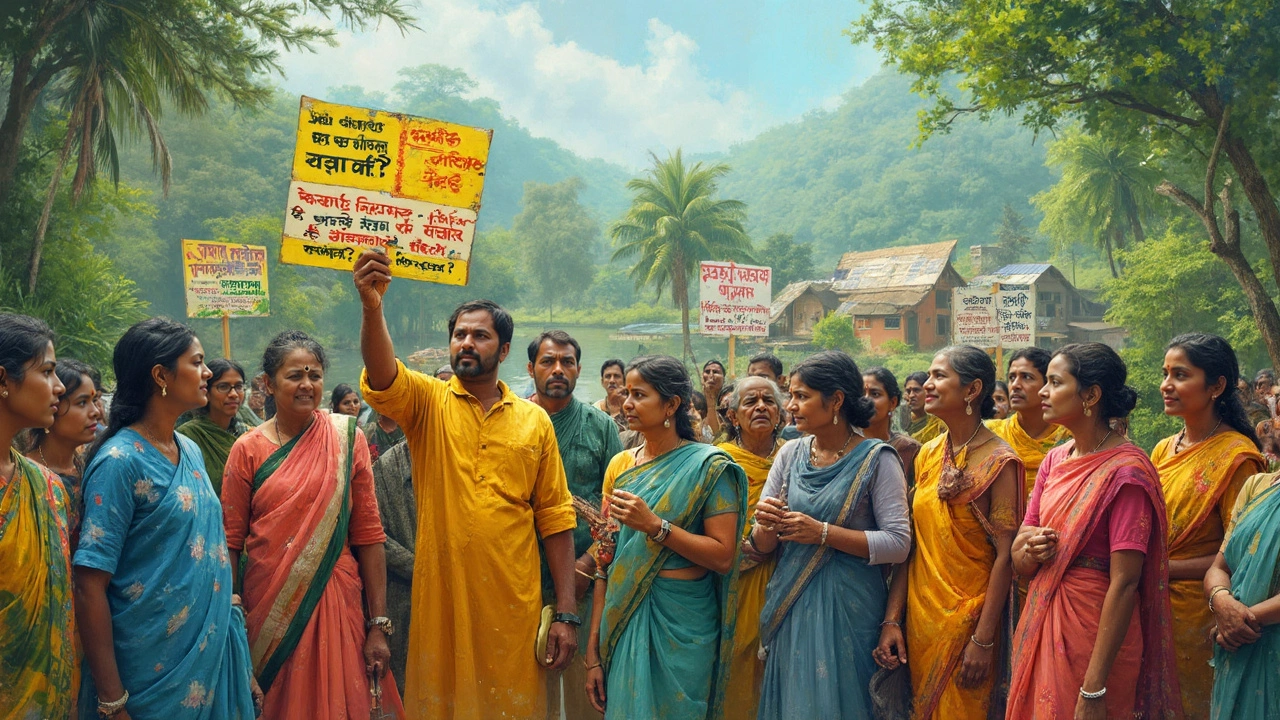Ever wondered how those small yet mighty environmental groups make such a big impact? While governments and corporations have a hand in shaping Earth's future, environmental groups are the real boots on the ground. These organizations, big and small, play a pivotal role in protecting our precious natural resources and promoting sustainability.
One of the most noticeable jobs they have is grassroots activism. These are the folks who organize local clean-ups, plant trees, and rally communities together for a greener cause. It's all about taking local action while thinking globally.
Then there's the policy game. Ever heard that phrase “the pen is mightier than the sword”? Well, these groups sometimes wield pens to influence big policy changes. They're pushing for tougher environmental regulations and laws that protect wildlife and limit pollution.
You'll also find them leading conservation efforts, often working to save endangered species or restore damaged ecosystems. When you think about the heartwarming stories of animals being brought back from the brink of extinction, there's probably an environmental group behind that success.
- Grassroots Activism
- Influencing Policies
- Conservation Efforts
- Public Awareness and Education
- Promoting Sustainability
Grassroots Activism
At its core, grassroots activism is all about ordinary people getting together to make an extraordinary impact. Ever attend a local park clean-up or community event aimed at raising recycling awareness? That's grassroots in action. These efforts build from the ground up, aiming to bring change right in neighborhoods and towns.
Grassroots activism isn't just feel-good volunteering; it's a powerhouse element in the mission of environmental groups. It's where passionate individuals come together to tackle local issues that can have a ripple effect on a larger scale.
Real-Life Impact
Take for instance the rise in community gardens across urban areas. These gardens do more than offer fresh produce; they increase green spaces and reduce carbon footprints. It's a double win. Not to mention, they bring folks together, fostering community spirit and environmental consciousness.
On another front, many activists join local groups to campaign for plastic bans in their towns. There's real power in numbers, and these focused efforts have resulted in legislation change within various municipalities across the globe.
How to Get Involved
If you're feeling inspired, getting involved is easier than you think. Here are a few ways to jump in:
- Join a local environmental group to stay informed about upcoming projects and movements.
- Attend town hall meetings and voice your concerns about environmental issues.
- Organize or participate in activities like cleanup drives or tree-planting events.
It's amazing what a small group of dedicated people can achieve. With enough momentum from grassroots movements, even the biggest environmental challenges can seem a little less daunting. Don’t underestimate the role that local efforts can play in pushing forward the goals of larger environmental groups.
Influencing Policies
When it comes to making real change, waving protest signs isn't the only way environmental groups get things done. A significant part of their work involves influencing policies—those rules that can make or break environmental progress. Their efforts can be seen in everything from local government meetings to international climate agreements.
Environmental groups often team up with scientists to provide solid research that backs their demands. This evidence-based approach helps policymakers see what's at stake. An example of this is how advocacy from groups like Greenpeace played a crucial role in the formation and promotion of the Paris Agreement, which aims to limit global warming.
Dr. Jane Goodall, a respected voice in conservation, once said,
"What you do makes a difference, and you have to decide what kind of difference you want to make."This quote resonates deeply with the strategic advocacy work done by these groups. They make noise where it counts, pushing for better climate policies and holding corporations accountable.
How They Do It
One way these organizations make their mark is by analyzing pending legislation and alerting both the public and decision-makers to any potentially harmful environmental consequences. This means you might receive an email urging you to sign a petition or call your representative. They engage in lobbying, sometimes employing skilled lobbyists who know the ins and outs of governmental workings.
Here's a quick list of their common tactics:
- Meeting with lawmakers to discuss environmental concerns
- Publishing reports that highlight the importance of sound environmental policies
- Organizing campaigns to rally public support
- Submitting formal comments during the policymaking process to suggest improvements or objections
According to a report by the Environmental Defense Fund, policy changes influenced by these groups have resulted in billions of dollars saved in public health costs from reduced air pollution. Now, that's a win-win for everyone!
Challenges They Face
The road to influencing policy isn't always smooth. These groups often face significant pushback from industries with deep pockets that might lose out due to stricter regulations. Despite these challenges, the tenacity of environmental groups continues to slowly but surely tip the scales toward a more sustainable future.

Conservation Efforts
When we dive into conservation, it’s about much more than just saving the cute animals, though that's part of it too! Environmental groups have boots on the ground and eyes on the skies to maintain biodiversity and protect ecosystems. From lush rainforests to vast oceans, these groups are all about preserving what makes our planet special.
Take, for instance, the Amazon Rainforest, often called the 'lungs of the Earth.' Organizations like Greenpeace are tirelessly working to prevent deforestation in this vital region. They use advanced satellite technology to monitor illegal logging activities. Fun fact: The Amazon produces about 20% of the world’s oxygen — not a resource we want to mess around with!
Reviving Endangered Species
Bringing back species from the brink of extinction is another biggie. The World Wildlife Fund (WWF) runs several projects focused on animals like the majestic tiger. Thanks to their tireless efforts, the number of wild tigers has increased to about 3,900 from what could’ve been a scary decline. That's a roaring success!
“Never doubt that a small group of thoughtful, committed citizens can change the world; indeed, it is the only thing that ever has.” — Margaret Mead
Conservation in Action: Marine Life
Let's not forget the role these groups play in protecting our oceans. Ocean Conservancy, for example, organizes the International Coastal Cleanup annually. This movement has mobilized millions worldwide to collect and document trash along their shorelines, leading to important data on how to tackle marine pollution.
They also partner with policymakers to establish Marine Protected Areas (MPAs). In these zones, ocean life is allowed to flourish with minimal human interference, ensuring a sustainable future for marine ecosystems. According to the IUCN, there are over 15,000 MPAs, which helps ensure our oceans can support life now and in the future.
| Species | Status | Improvement |
|---|---|---|
| Tigers | Endangered | Population increased to 3,900 |
| Sea Turtles | Vulnerable | Nesting sites increased |
In sum, the conservation efforts of these environmental groups are crucial. They’re not just saving animals; they're securing the very fabric of our natural world. Next time you hear a success story about a rescued animal or a saved forest, remember there's likely a dedicated group making it happen.
Public Awareness and Education
When it comes to making folks care about the planet, environmental groups know just how to get the message across. These groups are pros at turning complex scientific lingo into something we can all understand and, more importantly, care about.
One key tactic they use is educational campaigns. These campaigns aim to spread the word about the environment and inspire actions that can make a difference. Whether it's through social media, community workshops, or school programs, they're out there, sharing knowledge with people of all ages.
Let’s talk about schools for a minute. Many environmental groups have developed programs specifically for classrooms. This isn't just about planting a seed in the soil, but planting the seed of awareness in young minds. Imagine students participating in interactive projects that teach them about recycling, sustainable living, and the effects of climate change!
Partnering with Influencers and Celebrities
Another clever move is joining hands with influencers and celebrities. Ever noticed how many celebrities post about being eco-friendly? Often, environmental groups are behind these campaigns, leveraging star power to reach wider audiences.
Building Online Presence
In today's digital age, having a strong online presence is a must. Social media is the new frontier for spreading awareness, and these groups have a knack for creating engaging, shareable content that gets people talking. They’ve learned that a well-timed tweet or a viral video can reach millions without the need for a huge advertising budget.
You might also bump into live webinars or virtual talks hosted by these organizations. Such events not only raise awareness but also provide actionable steps we can all take to reduce our carbon footprint and live sustainably.
Finally, consider the availability of apps and tools that help individuals understand their environmental impact. By providing ways to monitor our own habits, these resources empower us to make changes for the better.
It's all about making the information accessible and relatable, so people aren’t just aware but motivated to act. In the end, creating a more sustainable world boils down to knowledge and action.

Promoting Sustainability
Environmental groups are key players in promoting sustainability across the globe. Their work goes beyond activism and policy influence. They are on the frontline of educating communities and businesses about sustainable practices. But what does that actually look like?
Encouraging Renewable Energy
One major focus is pushing the adoption of renewable energy. With climate change threatening our future, switching to sustainable energy sources is crucial. Groups advocate for solar panels, wind turbines, and other clean energy technologies. Did you know that in 2023, the installation of solar panels increased by 20% due to advocacy campaigns?
Supporting Sustainable Agriculture
Food production is another area where these groups make a big impact. Sustainable agricultural practices are essential to reducing the ecological footprint of the agricultural sector. Organizations work with farmers to implement crop rotation, organic farming, and water conservation techniques. These methods not only benefit the environment but also help farmers produce healthier food.
Promoting Responsible Waste Management
Reducing waste is a classic sustainability goal. Environmental groups often lead initiatives that teach people about recycling, composting, and reducing single-use plastics. Some have successfully lobbied for laws banning plastic bags and straws in various states.
Education and Community Involvement
One of the best tools in their arsenal is education. By hosting workshops and seminars, they help communities understand the importance of sustainable living. People are more likely to support sustainability when they see how it benefits them directly. The combination of community involvement and smart solutions creates lasting change.
So, as you can see, the work of these organizations is quite varied but vital. Through their innovative approaches, they're helping us all move towards a more sustainable future.





